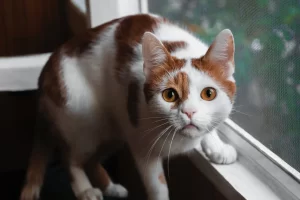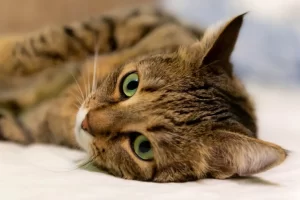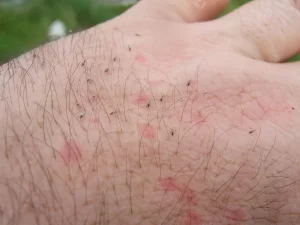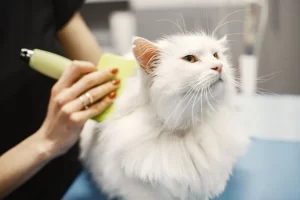Fleas are a common problem for cats, and can cause a variety of symptoms including itching, scratching, and skin irritation. These tiny insects are not only a nuisance for your feline friend, but they can also cause serious health problems if left untreated. In this article, we will explore the causes of flea infestations in cats, as well as a variety of home remedies that can help to alleviate symptoms and eliminate the fleas themselves. From natural remedies to over-the-counter treatments, we will discuss everything you need to know to keep your cat free from fleas and ensure their overall health and well-being.

Table of Contents
ToggleWhat do cat fleas look like?
Cat fleas, also known as Ctenocephalides felis, are small, wingless insects that are known to feed on the blood of cats and other animals. They are brown in color, and are typically around 2-3 millimeters in length. They have a flattened body shape, which allows them to easily move through the fur of their host. Fleas are known to have six legs, each with a claw at the end to help them move through fur and hair. They are also covered in small spines, which help to protect them from being groomed off by their host. In terms of appearance on cats, fleas are not easy to spot and can be hard to see with the naked eye. They are small and move quickly, and often hide in the fur of the cat, making them difficult to detect. However, signs of flea infestation can include excessive scratching, biting, or licking of the skin, as well as red, irritated areas on the skin. Here you can see some more real images of fleas that also show how they look like to the human eye.
Main symptoms of a cat with fleas
Cats with fleas may exhibit a variety of symptoms, including:
- Itching and scratching: The most common symptom of flea infestation in cats is excessive itching and scratching of the skin. This is caused by an allergic reaction to the flea’s saliva.
- Skin irritation and redness: Fleas can cause skin irritation and redness, particularly around the neck, ears, and base of the tail.
- Bald patches: Constant scratching and biting at the skin can lead to hair loss and bald patches on the cat’s coat.
- Hot spots: Fleas can cause hot spots, which are red, swollen, and painful areas of skin that are caused by excessive scratching and biting.
- Flea dirt: You may see small black specks on the cat’s skin or fur, which is called flea dirt. It’s actually flea feces, and if you wet it and it turns red, it’s an indication of flea infestation.
- Anemia: In severe cases, flea infestations can lead to anemia, a condition in which the cat’s body does not have enough red blood cells to function properly. This can be caused by blood loss from excessive flea biting.
It is important to note that not all cats will show symptoms of flea infestation, so it is important to regularly check for the presence of fleas and flea dirt on your cat, even if they don’t show any signs of discomfort. Consider trying these steps to see if your cat has fleas or not.
Related read: What Fleas Do to Cats and Kittens
home remedies for fleas on cats (with and without bathing)
- Vacuuming: Regularly vacuuming your home, especially carpets and furniture, can help to remove fleas and their eggs. Be sure to empty the vacuum cleaner bag after each use to prevent the fleas from escaping back into your home.
- Boric acid: Boric acid is a natural insecticide that can be used to kill fleas. Mix a small amount of boric acid with water and sprinkle it on carpets and furniture. Be sure to vacuum the area thoroughly after 24 hours.
- Lemon spray: Lemon juice is a natural flea repellent. Mix the juice of one lemon with water and spray it on your cat’s fur and in your home.
- Salt: Salt can be used to dehydrate fleas and their eggs. Sprinkle salt on carpets and furniture and leave it for 24 hours before vacuuming.
- Diatomaceous earth: Diatomaceous earth is a powder made from fossilized algae that can be used to kill fleas. Sprinkle it on carpets, furniture, and pet beds and vacuum it up after 24 hours.
- Apple cider vinegar: Apple cider vinegar can be used as a flea repellent. Mix equal parts apple cider vinegar and water and spray it on your cat’s fur and in your home.
- Herbs: Certain herbs such as rosemary, thyme, and peppermint can be used to repel fleas. Place small sachets of these herbs in areas where your cat spends time, such as on furniture and in bedding.
- Essential oils: Essential oils such as lavender, eucalyptus, and cedarwood can be used to repel fleas. Mix a few drops of the oil with water and spray it on your cat’s fur and in your home.
- Flea comb: Regular grooming with a flea comb can help to remove fleas and their eggs from your cat’s fur. Be sure to dip the comb in soapy water after each pass to drown the fleas.
- Flea traps: Flea traps can be used to capture fleas in your home. These traps use light and heat to attract fleas, which are then trapped on a sticky surface.
- Cold treatment: Fleas and their eggs can be killed by freezing. Place infested items such as bedding and clothing in plastic bags and put it in the freezer for at least 72 hours.
- Hot treatment: Fleas and their eggs can also be killed by heat. Place infested items in the dryer on high heat for at least 30 minutes.
- Tea tree oil: Mix a few drops of tea tree oil with water and use it as a spray on your cat’s fur and in your home.
- Neem oil: Mix a few drops of neem oil with water and use it as a spray on your cat’s fur and in your home.
- Garlic: Feeding your cat garlic can help to repel fleas. You can give your cat fresh garlic or garlic supplements.
It’s important to note that, while these home remedies can be effective at getting rid of fleas, it’s best to consult with your veterinarian before using them. Some remedies may not be suitable for all cats. Also, keep in mind that it’s essential to follow the instructions carefully, and use these remedies in combination with other flea control methods, like regular grooming and vacuuming.
Read More: How often do you take a cat to the vet?
What to do and not to do when your cat have fleas?
When your cat has fleas, it is important to take action to eliminate the infestation as soon as possible. Here are some things to do and not to do when your cat has fleas:
Do:
- Consult with your veterinarian to determine the best treatment plan for your cat.
- Use a flea comb to remove fleas and their eggs from your cat’s fur.
- Vacuum your home regularly, including carpets, furniture, and pet beds, to remove fleas and their eggs.
- Wash your cat’s bedding and any other items that may have come into contact with fleas in hot water.
- Treat your home and yard to eliminate fleas.
- Keep an eye on your cat’s health and look out for signs of anemia, hair loss, or secondary infections.
Don’t:
- Don’t use human flea and tick products on your cat, as they can be harmful.
- Don’t use flea and tick products that are not labeled for use on cats. Fleas can live on other animals as well as humans! They can even bite humans!
- Don’t ignore the problem, as it will only get worse over time.
- Don’t use flea and tick products that contain organophosphates and carbamates, as they can be toxic to cats.
- Don’t rely on one method to control fleas, use multiple methods.
It’s important to keep in mind that getting rid of fleas can take time and patience. It’s essential to follow the instructions on any flea control products you use and to use them in combination with other flea control methods. Additionally, it’s important to continue monitoring your cat’s health and to take action if you notice any signs of anemia, hair loss, or secondary infections.
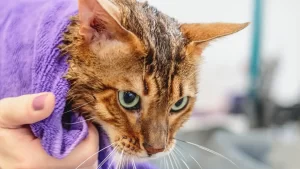
How does bathing help in removing fleas from cats?
Bathing can be helpful in getting rid of fleas for a few reasons:
- Physical removal: Fleas can be washed off of your cat’s fur during a bath, which will physically remove them from your cat’s body.
- Drowning: Fleas and their eggs can be drowned during a bath. Soap and water can suffocate fleas and their eggs, killing them.
- Grooming: Bathing your cat will also help to groom your cat, which can remove flea eggs, and other debris from your cat’s fur.
- Repellent: Some flea shampoos contain ingredients that can repel fleas, such as pyrethrins and pyrethroids. These ingredients can help to keep fleas away from your cat’s fur after the bath.
It’s important to note that while bathing can be helpful in getting rid of fleas, it’s not a standalone solution. After the bath, it’s important to continue to use other flea control methods such as vacuuming and treating your home, as well as keeping an eye on your cat’s health and looking out for signs of anemia, hair loss or secondary infections.
It’s also important to use a flea shampoo specifically formulated for cats, as some human shampoos or other types of shampoos can be harmful to cats. And, always consult your veterinarian before using any product on your cat.
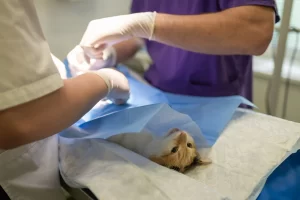
Watch the methods used to remove fleas from cats:
What are the main causes of fleas in cats?
- Exposure to other animals: Cats that come into contact with other animals that have fleas, such as dogs or outdoor cats, are at a higher risk of developing a flea infestation.
- Environment: Fleas thrive in warm, humid environments, so cats that live in areas with high temperatures and humidity are more likely to get fleas.
- Lack of grooming: Cats that are not regularly groomed or bathed are more likely to develop a flea infestation, as fleas are able to hide in their fur and reproduce more easily.
- Unsanitary living conditions: Fleas can also thrive in unsanitary living conditions, such as dirty carpets, bedding, or furniture.
- Outdoor exposure: Cats that spend a lot of time outside are more likely to come into contact with fleas, as they can live in the environment and be present in areas such as grass, soil and foliage.
It’s important to note that fleas can multiply quickly and cause an infestation in a very short time, it is important to detect and treat them as soon as possible.
Where are fleas commonly found on cats?
Fleas are notably inclined to take residence on various regions of a cat’s body, with particular preferences driven by their environmental needs and feeding habits. While fleas can potentially infest any part of a cat’s body, they often cluster in the following areas:
- Lower Half of the Body: Fleas are most frequently encountered on the lower half of a cat’s body, which includes the legs, belly, and tail. These areas offer fleas ample access to a cat’s blood supply and facilitate feeding.
- Ears and Neck: The base of a cat’s ears and the neck area are prime spots for flea infestation. These locales provide a warm, sheltered environment where fleas can comfortably reside and lay their eggs. Cats may scratch or groom vigorously in response to the irritation caused by fleas in these areas.
- Anywhere on the Body: Fleas are agile and can traverse a cat’s entire body, so it’s crucial to recognize that they can be found in numerous areas. Vigilance is key to detecting fleas regardless of their location.
- Surrounding Environment: Beyond residing on the cat itself, fleas can also infest a cat’s bedding, living areas, and other surroundings. Regular cleaning and treatment of these spaces are essential to prevent reinfestation.
What if cat fleas are left untreated?
If fleas are left untreated, they can cause a variety of problems for your cat. One of the most obvious symptoms of flea infestation is itching and scratching, which can lead to hair loss and irritated, red skin. In some cases, a cat may also develop a secondary bacterial infection as a result of excessive scratching. Fleas can also cause anemia in cats, especially in young or frail cats, as they can consume a lot of blood which can lead to anemia. Additionally, fleas can also spread tapeworms to cats if they are ingested while grooming. Furthermore, fleas can also infest your home and become a persistent problem that is difficult to eliminate. So, it is important to take action as soon as you notice signs of fleas on your cat, in order to prevent these problems from becoming more severe.
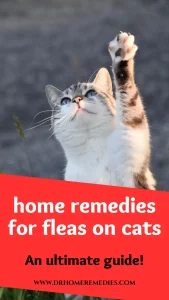
Medical treatments of fleas on cats
There are several medical treatments that can be used to treat fleas on cats. The most common approach is to use a topical or oral medication that contains an insecticide that kills fleas. Some of the most commonly prescribed products include:
- Topical treatments such as spot-on treatments, which are applied to the skin on the back of the cat’s neck. These products typically contain an insecticide such as fipronil or imidacloprid.
- Oral medications such as tablets or capsules that contain nitenpyram, lufenuron or spinosad. These products are usually given to the cat once a month, and they work by killing adult fleas and preventing flea eggs from hatching.
- Shampoo and sprays: Some flea shampoos and sprays contain pyrethrins or pyrethroids that can kill adult fleas and some ticks on contact.
- Environmental treatment: Flea sprays, flea bombs and flea powders can be used to treat the environment such as carpets, furniture, and pet beds to kill any fleas that may be present there.
It’s important to note that, before starting a flea treatment, you should consult your veterinarian to determine the best course of treatment for your cat. Your veterinarian will consider factors such as your cat’s overall health, lifestyle and environment to determine the best treatment plan.
When to see a vet for a cat flea?
It’s important to see a vet if your cat has fleas for a few reasons:
- To confirm the diagnosis: A vet can examine your cat and confirm that it does indeed have fleas. This will allow you to take the appropriate steps to eliminate the infestation.
- To determine the best treatment plan: A vet can help you determine the best treatment plan for your cat based on its overall health, lifestyle, and environment. They may recommend a specific type of flea control product or a combination of products.
- To check for secondary infections: Flea infestations can lead to secondary infections, so your vet will check your cat’s skin, ears and overall health condition and may prescribe medication if needed
- To check for anemia: Fleas can consume a lot of blood, especially in young or frail cats, which can lead to anemia, a condition where the cat’s body doesn’t have enough red blood cells. Your vet can check your cat’s blood count and may prescribe supplements if needed.
- To check for tapeworms: Fleas can carry tapeworms, and if ingested by cats, it can lead to tapeworms infection (see other reasons for tapeworms in cats). A vet can check for tapeworms by looking at the cat’s feces and will prescribe medication if needed. If your cat has tapeworms (or worms in general), use these natural remedies to get rid of them at home.
It’s important to keep in mind that even if you don’t see any signs of fleas on your cat, it’s a good idea to have your vet check your cat regularly as a preventive measure, especially if you live in an area with a high flea population or if your cat goes outside frequently.
References:
- Fleas: A Source of Torment for your Cat.
- Flea Control in Cats
- Rust MK. The Biology and Ecology of Cat Fleas and Advancements in Their Pest Management: A Review. Insects. 2017 Oct 27;8(4):118.
- Rust MK. Recent Advancements in the Control of Cat Fleas. Insects. 2020 Sep 29;11(10):668.
- Khawcharoenporn T, Thongphubeth K, Auimsirinukul S, Saichua P, Bunjoungmanee P. Control of Cat Flea Infestation in Neonatal and Pediatric Intensive Care Units. Open Forum Infect Dis. 2017 Oct 4;4(Suppl 1):S175–6.



